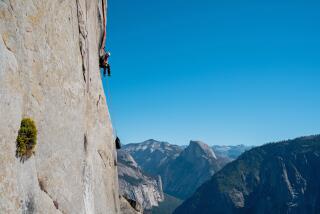Riding the winds of change
As the ancient Dodge van bumped and creaked up the mountain road to one of Southern California’s legendary hang glider launches, a 68-year-old thrill-seeker sitting in back mentioned that the 83-year-old riding shotgun is attracting condors whenever he flies.
“He thinks it’s because he talks to them,” George Boswell said of his older friend, Rome Dodson. “We don’t have the heart to tell him it’s because they’re vultures.”
There’s never been a shortage of gallows humor among hang glider pilots. They confront mortality every time they stare down at the world from thousands of feet with only a hollow aluminum frame and a thin sheet of Dacron holding them aloft.
But as the age of a typical “hangie” soars into the 60s and 70s, many worry less about their own survival and more about the future of the sport they love and helped invent in the sun-baked mountains around Los Angeles.
Today, most younger pilots favor the soft-winged paraglider — a steerable parachute with no rigid frame — pioneered by French alpinists looking for something light and compact enough to stuff into bags and carry on their backs up rugged peaks. From there, they would launch themselves for an aerial tour of their climbing route and a suitably stylish descent to the valley floor.
From the outside, it would seem the camps have a lot in common. Any two people who are willing to strap themselves to a wing and run off a mountain cliff, hoping to ride columns of warm, rising air to 10,000 feet or higher obviously share a rare and overpowering faith in something: God, physics, luck?
But like followers of any creed who go their separate ways — think skiers and snowboarders — hang gliders and paragliders sometimes regard each other with a suspicion that borders on tribal.
For hang gliders, there is a practical concern: Fewer pilots means manufacturers may go out of business, making it hard to replace worn-out gear. But there is an emotional side, too: Many hang gliders have risked their lives for decades and seen friends killed honing skills that allow men to soar like birds of prey. It hurts to see that knowledge abandoned in favor of a sport that at first seems as hard to master as sitting in a lawn chair.
One of the few young hang glider pilots left, 27-year-old Ryan Voight, said he knew he was living dangerously when he posted a message on hanggliding.org admitting he’d recently tried paragliding. And liked it.
The message board (plastered with advertisements for a “mature singles” dating service) erupted with outrage. Curmudgeonly hang gliders accused Voight of harboring an anti-hang-gliding agenda, demanded to know if he was an undercover paragliding instructor trolling for business and suggested his views would be more welcome among his own kind, on a paragliding forum.
One aggrieved hang glider wrote: “We have a right to not have PG shoved down our throats all the time.”
As it turns out, Voight is a second-generation hang glider. His dad owns a hang gliding school and shop in New York. The younger Voight teaches whenever he can near his home in Utah, where he supplements his income as a ski instructor.
Despite the ostracism, Voight is still paragliding. He is not the only turncoat.
Bowing to the seemingly inevitable, the U.S. Hang Gliding Assn. added “and Paragliding” to its name a few years ago. In 2011, the number of paragliding members (4,066) surpassed the number of hang gliders (3,922) for the first time.
“It’s hard because hang gliders started it all in the 1970s, when they were in their 20s or 30s, but now they’re getting to the point where they can’t do it anymore,” said Nick Greece, 35, the association’s spokesman.
Besides, a hang glider is “a way cooler craft … it flies faster, it can fly in more wind,” Greece offered, just before confiding that he flies a paraglider. He is, in fact, a world-class competitor in the sport.
One problem with hang gliders is their big, awkward frames. Getting them up the hill usually requires a truck, or a large van, with a roof rack. Once at the launch, it takes time to assemble their metal tubes, steel wires and complicated harnesses.
That rigid frame, though, means most hang gliders can fly twice as far and twice as fast as most paragliders and, significantly, a hang glider will knife through the turbulence surrounding rising columns of air — known as thermals — with much less drama. But it takes longer to learn to handle all the power.
That’s why most newcomers are flocking to paragliders, prompting old hangies, who in their youth were derided as “sky bums,” to despair that the younger generation is addicted to instant gratification.
The simplicity of paragliding can be intoxicating. The backpack doubles as a well-padded, L-shaped harness. Sitting in it feels a lot like being in a recliner. The wing and the Kevlar lines that dangle beneath it come neatly out of the pack and attach to the harness with two simple, locking metal loops. The setup takes a couple of minutes and can easily be done by one person.
Once he steps into the harness, the pilot takes a few quick steps forward into a soft breeze and the wing rises overhead with a loud, satisfying whoosh. A few more brisk steps downhill and the ground slips gently away.
Getting the takeoff right requires a bit of practice, but absolute beginners can be soloing hundreds of feet above the training hill — there’s a famous one in Santa Barbara — an hour or two into their first lesson. Turning consists of leaning to one side in the harness and pulling gently down on a handle attached to the lines, a motion not unlike reaching for a beer from the comfort of a La-Z-Boy.
In calm air, like the gentle uplift found along California’s coastal ridges, a flight can last hours and feel dream-like, allowing the pilot to float back and forth in a kind of quiet meditation. Done right, landings are similarly serene. The pilot gently places himself on terra firma by pulling down on both handles a few feet above ground and stalling the wing.
One problem with such a gentle learning curve, say some veteran hang gliders, is that naive paraglider pilots don’t have the sense to stay in calm air. Instead, they’ll take their fragile wings to the roaring thermal turbulence of the desert, where they can soar to 15,000 feet and cover a hundred miles in a single flight.
Reliable accident statistics are impossible to find because neither the Federal Aviation Administration nor the National Transportation Safety Board tracks fatalities involving foot-launched, engine-less aircraft. Accident reports on the hang gliding and paragliding association’s website are mostly anecdotal and rely on voluntary submissions from pilots and witnesses.
But a Web search on “paraglide and collapse” turns up horrifying video clips showing what can happen when soft wings encounter strong turbulence.
With no frame, a paraglider depends on air flowing in from the front to fill the space between an upper and lower layer of fabric. When inflated, the material forms the shape of a wing and it flies. If air is suddenly forced out, however, the wing loses shape and a pilot can find himself thousands of feet above the ground with a bundle of useless cloth overhead.
Beginner wings designed for safety are supposed to reinflate when they start to fall. But that can take enough time for the pilot to drop a few hundred feet. If a wing collapses too close to the ground, there’s very little a pilot can do except deploy the reserve parachute, which also takes precious seconds.
Competition paraglider wings, designed for maximum speed and range, do not reinflate so easily. Two pilots were killed on the same day at the paragliding World Championships in Spain last July after their wings collapsed, and three others saved their lives only by opening reserve chutes.
“If I thought there was any chance my aircraft was going to spontaneously stop being an aircraft in flight, I would not get on it,” said Rick Masters, a onetime hang glider who, after watching two paragliders plummet to their deaths, created a website devoted to the study of fatal paragliding accidents. Combing the Web for news accounts, he’s up to 873 since 2002.
When he posted his findings on a paragliding forum, he was called a “fool,” a “screwball” and a “psychopath.” One angry paraglider wrote: “You are an old fart who used to fly and enjoy himself. Now you see ‘your’ sport threatened by these upstart paraglider pilots.”
Masters, 61, lives in California’s Owens Valley, home to some of the best thermal soaring in the world. He said he understands the response: Paragliders are “not going to let anyone take away their toys.” He felt the same way about hang gliding — which, he concedes, is also plenty dangerous.
But he swears he didn’t quit out of fear. Instead, he said, after about a decade of flying, he found himself soaring one day at 17,000 feet. He looked down at the ground and thought, “I’m bored. I gotta do something else, maybe build a house.”
For others, the magic of flight doesn’t wear off so easily.
Eighty-three-year-old Dodson was a pioneer when he started hang gliding almost 40 years ago. He tried paragliding, but on one of his maiden flights he went into an unexpected spiral dive after launching from 3,500-foot Kagel Mountain, about 30 miles north of downtown Los Angeles. “If I’d hit the side of the hill then, I would’ve been mush,” he said.
In his late 60s at the time, he decided to stick with the wing he knew. He doesn’t fly as often as he’d like these days because of back and respiratory trouble. So he gets his fix accompanying fellow members of what he calls the “Sylmar Senile Senior Soaring Society” to the top of the mountain in a 1988 Dodge van with 381,000 miles on it.
His last flight was on his birthday in October. “I got pretty winded getting into the harness, and winded again walking over to the launch,” he said, standing at the edge of the cliff with the San Fernando Valley spread out more than a thousand feet below and the downtown skyline peeking over ridges to the south.
“But once I was in the air, and the weight was gone, I could do it,” he said. “I was fine.”
More to Read
Sign up for Essential California
The most important California stories and recommendations in your inbox every morning.
You may occasionally receive promotional content from the Los Angeles Times.










